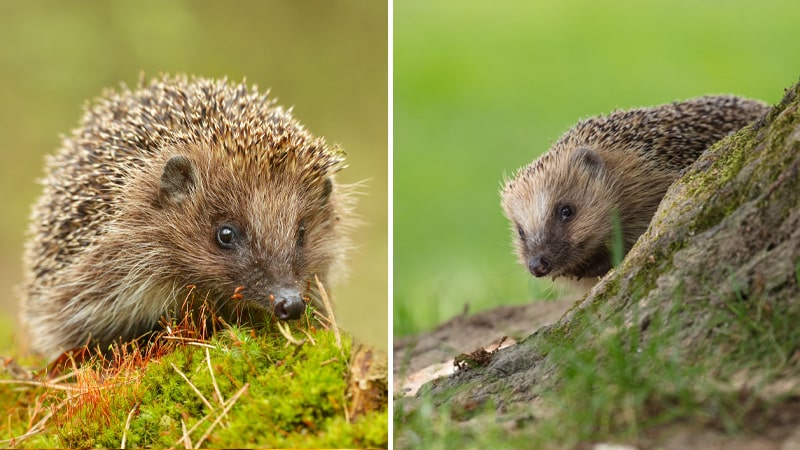Hedgehog numbers are in serious decline
It’s Hedgehog Awareness Week, a time of the year to celebrate our favourite spiky mammal. But it’s also a time to reflect on the fact that their numbers are in serious decline. It’s no longer a common sight to see these shy little creatures moving slowly through our gardens.
It’s estimated that there were some 30 million hedgehogs in Britain in the 1950s. By the 1990s, this number had plummeted to 1.5 million. In 2020 the hedgehog was added to the Red List for British mammals, listed as a creature at risk of extinction.
The State of Britain’s Hedgehogs 2022 report has found that the largest decline in the hedgehog population is in rural areas, whereas numbers in urban areas remain low but stable. The report shows
“a loss of hedgehogs in rural areas nationally of between a third and three-quarters of the population in the last two decades. The largest declines are in the eastern half of England.”

Loss of habitat, pesticides, fencing
So why, exactly, are we losing our favourite mammal?
Hedgehogs rely on hedgerows and forest edges for both shelter and food. Hedgerows form a protected pathway, helping them to move around without predation. So the loss of these habitats is having a big impact on their ability to survive.
It’s also common knowledge that toxic pesticides — used widely all over the country on both farmland and in gardens — reduce hedgehogs’ food supply. In the UK, the use of pesticides continues to rise: by 2016, 73 million hectares of land were being sprayed, often multiple times.
In more urban areas, the building of new developments, the loss of greenery in gardens, and impermeable fencing all have big effects on a hedgehog’s ability to survive.
Roads, of course, continue to affect mammals, with many thousands of hedgehogs killed by vehicles every year.

What can you do?
If you live in a built-up area, you might wonder what you can do to help our hedgehogs. But urban spaces are essential for the mammal’s survival. According to the British Hedgehog Preservation Society (BHPS) and the People’s Trust for Endangered Species (PTES):
“The matrix of gardens and green spaces in towns and cities can support the highest densities of hedgehogs and may act as a refuge from agricultural practices and high predator density.”
So there are a number of steps that you can take, especially if you have a garden.
1) Stop using pesticides in your garden
In April 2022, it became illegal to buy or use metaldehyde slug pellets in the UK. There are differing opinions on how much this poison has affected hedgehogs. A few hedgehogs have been found dead with high levels of metaldehyde in their bodies, while there are concerns that the poison also affects a hedgehog’s reproductive ability, too. It’s important to raise awareness in your community about the banning of metaldehyde slug pellets. There are a number of natural ways that you can repel slugs in your garden.
Other pesticides also affect hedgehogs, and are toxic if ingested. Queen Mary’s Hedgehog Friendly Campus campaign says:
“Herbicides…reduce worm population which is not only the main food source [for] hedgies, but also in badgers. A decline in the badger’s food source could indirectly cause an increase in predation rate on hedgehogs.”
So if you care about hedgehogs, ditch not just toxic slug pellets, but all pesticides, and look for organic ways to manage your garden.
2) Make a hedgehog highway
Hedgehogs like to move between gardens. Hedgehog highways ensure that they can move freely, without coming across barriers. To contribute to a hedgehog highway, you can make a hedgehog-sized hole in your outdoor wall or fence. The hole should be 13cm X 13cm. BHPS and PTES are asking you to log your hedgehog holes on the Big Hedgehog Map. On top of this, you can add your hedgehog sightings onto the map, too.
3) Make your garden hedgehog-friendly
These days, too many gardens are perfectly manicured or lack any vegetation entirely. To make your garden more hedgehog-friendly, you can create a wild corner, letting dense undergrowth thrive. Make sure you have grass of varying lengths in your garden and leave fallen leaves on the ground. These give hedgehogs plenty of habitat to hide and nest. You can also create a log pile, which will offer a hedgehog shelter and food.
4) Make a hedgehog home
You can leave a box in your garden to provide a safe place for a hedgehog to nest and shelter. You can build your own, or buy one from the RSPB, which also gives you tips on where to position your hedgehog home.
5) Provide hedgehogs with food and water
Don’t feed hedgehogs bread and milk because they can’t digest them. Instead, give them complete cat food or meaty dog and cat biscuits. The RSPB also advises:
“If you have a pond, make sure you provide platforms and sloped routes out of the water. Hedgehogs like to drink from ponds and can sometimes fall in. Although they’re good swimmers, it can be dangerous not to have a quick exit.”
You can also build a feeding station for safe feeding.
6) Ask your school or university to become a hedgehog-friendly campus
The BHPS has funded a programme, offering free support to schools, universities and colleges to make their campuses more hedgehog-friendly. This year it wants more primary schools to get involved.
BHPS says:
“You’ll be completing activities that protect hedgehogs from hazards, enhance their habitat and raise awareness about hedgehog decline. You’ll get access to loads of free classroom activities, campaigning resources and advice. You’ll also get free mammal survey resources so you can see what animals are visiting.”
Read how to get involved here.
7) Contact your local council
Come together with the rest of your community. Pressure your council to make your area more hedgehog-friendly. Encourage the council to rewild an area, plant hedges, and install hedgehog highways.


